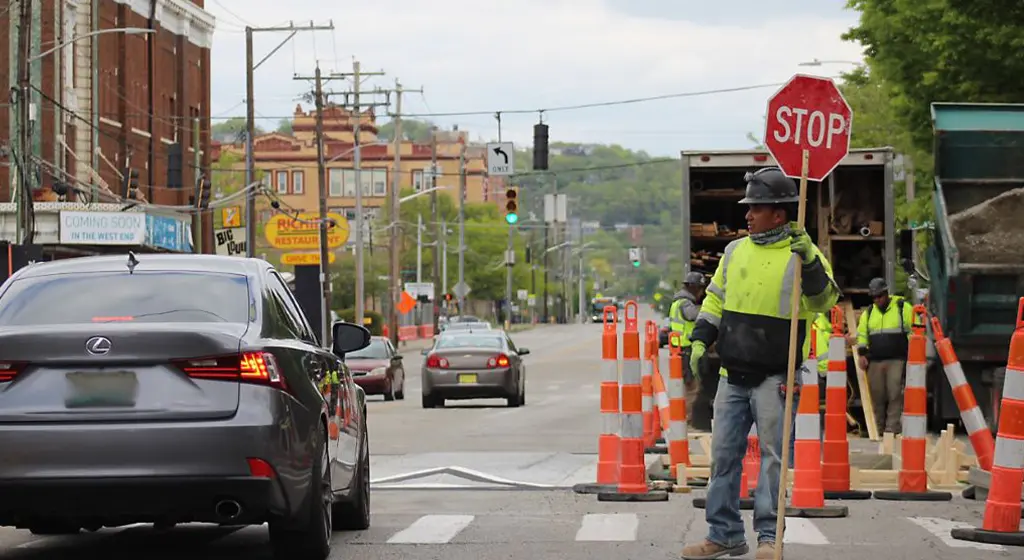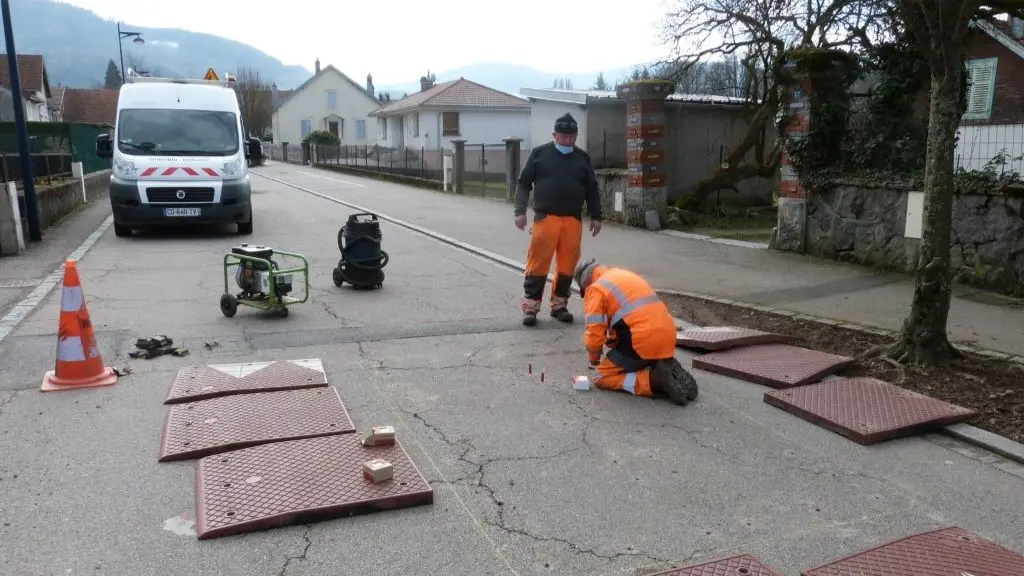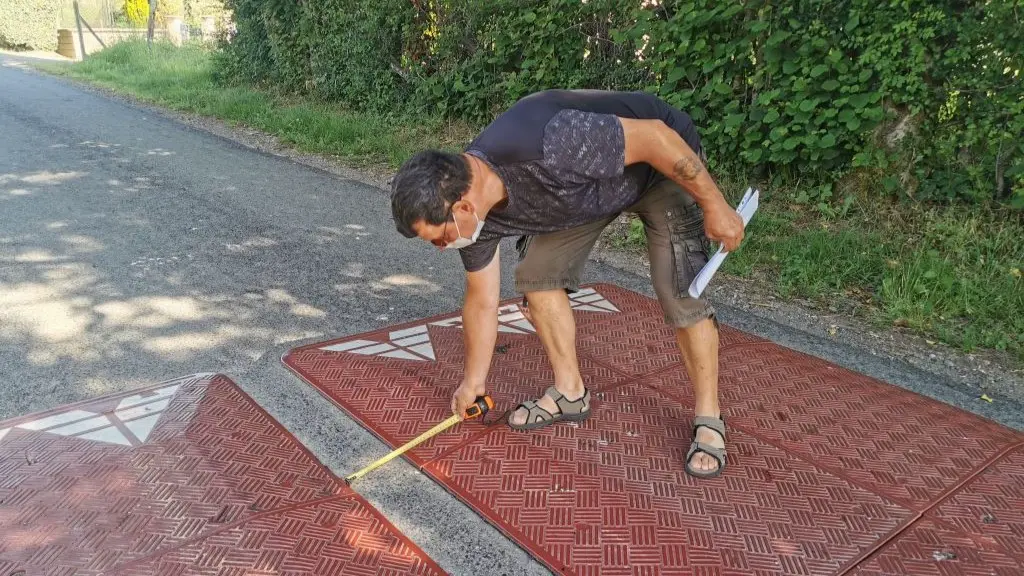How to Install a Speed Cushion?
Speed cushions are innovative and efficient traffic-calming devices made out of recycled plastic. They are used to slow down traffic and reduce traffic congestion without causing discomfort to the passengers upon collision with the cushions.
What makes them so effective compared to speed breakers is that they only reduce the speed of vehicles like cars, motorcycles, and bicycles, not huge emergency vehicles. This is because the cushions are divided into sections and allow emergency vehicles such as ambulances and fire trucks with wider wheelbases to go through them without any hindrance.
For more information about Speed Cushions, you can discover here: Speed Cushions: All answers to your questions.
In most cases, these speed-reduction cushions are installed in various municipalities vulnerable to accidents due to overspeeding, especially the roads leading to schools, hospitals, work zones, pedestrian zones, and airports.
However, one must practice extreme precautions to install these devices on the roadway since the measurements between the individual speed cushions should be accurate.
But how does that happen? Read along to learn how you can effectively install a speed cushion!

Discover here our full range of Speed Cushions!
What do you need to prepare to install a speed cushion?
Speed cushions are suitable speed control measures that ensure the road traffic safety of municipalities and city streets is never compromised.
However, installing them can be the trickiest part.
A minor fault in installing speed cushions can ruin your efforts and cause problems for cars, buses, bicyclists, emergency vehicles, and pedestrians. Therefore, several necessary precautions should be considered before and during the speed cushion installation process.
Firstly, protect yourself and wear eye protection glasses, as drilling into the concrete can cause eye soreness. Do not forget to place signage, stop signs, signposts, traffic speed limit signs, warning signs, parking signs, regulatory signs, and road markings to warn the incoming traffic and pedestrians of the work in progress on the road ahead.
In addition, clean the part of the road where the speed calming cushions will be applied, and always ensure that there’s no moisture in or around the speed cushion, as it will make the adhesive ineffective.
When installing road cushions in a residential area, make sure the people living there do not have any concerns with the installation. Don’t forget to conduct thorough research before initiating the installation process and strictly follow the speed cushion regulations related to maximum allowed dimensions and other variables.

The tools you will need
The essential tools and materials used in installing the speed cushions are as follows:
- Chalk
- Measuring tape
- Drill bits
- Drive Socket
- Decent-sized air compressor.
- Hammer drills
- Masonry drill bits.
- Caulking gun
- Dust masks
- Eye protection glasses
Get in touch
The Speed Cushions Factory is a leading manufacturer of rubber speed cushions located in Qingdao, China.
Feel free to contact us!
We are always here to help!
Qingdao, Shandong Province, China.
sales@speed-cushion.com
Steps for installing a speed cushion
Now you have all the resources and safety gear ready to install a speed cushion. Let’s walk you through a step-by-step guide to install a speed cushion perfectly!
- Thoroughly clean the site to install on.
- Use chalk to mark the exact position where the road cushions will be placed. Markings should be parallel to the edge of the road and at the top and bottom of where the speed cushion will be placed perpendicular to the road.
- The rubber speed cushion will then be placed on the road with the Angle Iron underneath the slots.
- The modules of the speed cushion that run parallel to the right and left sides of the road will be separated.
- After assembling the first row of units, use a hammer of the tongue and groove method to interlock.
- Use paint or tape to mark the drill bit 8-9 inches deep, followed by a hammer drill to drill holes in the first row.
- Once the drilling is completed, use an air compressor to clear all the dust and debris from the holes.
- Insert 2-3 squirts of adhesive into the holes, and then use a sledgehammer to push the plastic anchors inside the holes.
- Immediately insert and install the bolt-washer assembly using a drill.
- Once the first row is completely installed, move on to the next module and repeat the steps.

How far apart should speed cushions be placed?
Carrying out proper measurements is one of the most crucial steps during speed cushion installation. Any misplacement of the road speed cushion can have catastrophic effects.
You need to take care of two measurements while installing the traffic-calming cushions, which include:
- The distance between the individual speed cushions
- The distance between two sets of speed cushions on a single road
The distance between a speed hump or speed breaker in a single set of speed cushions should be determined by the state of usual traffic running on the road. In a street where accidents mostly occur due to over-speeding, such as parking lots and parking zones, one single speed cushion is used across the length of the road along with traffic signs, speed signs, signposts, and traffic control signs.
However, regular and standard traffic volume roadways, such as roundabouts, work zones, and school zones, have road speed cushions installed in pairs with an adequate distance between each pair. The gap between the speed cushion ensures that emergency vehicles with wider wheelbases can pass through them without slowing down.
There would not be just a single set of traffic speed cushions installed on the road. Multiple cushions with the perfect distance between each set of road cushions are needed to ensure a smooth traffic flow.
These traffic calming measures should be installed at least 150-250 yards apart or 65-100 yards in lanes. If the cushions are placed too close to each other, motorists, bicyclists, and other road vehicles will have to stop more often, causing ineffective traffic.

Additional Tips
See, installing speed cushions alone won’t be enough to slow traffic and discourage drivers from avoiding over-speeding. Additional deflection measures should be installed alongside speed cushions to ensure effective traffic control, ultimately improving pedestrian safety.
The first tip is to install speed limit signs, crossing signs, operating traffic signals, and parking signs, which will alert the driver to drive in specific miles per hour (mph) range.
Another tip is to install deflections and road narrowings which prevent the drivers from over-speed. Some important tools include pavement markings, bollards, sidewalks, and ramps.
When installed with speed cushions, all these measures will work harmoniously to promote effective traffic control on roadways.

Conclusion
Speed cushions are extremely effective and efficient traffic control devices that reduce the chances of vehicle crashes and decrease traffic noise. However, a slight mistake in installing these cushions can cause major problems and fatalities. Hence, the process needs to be handled professionally, as the safety of the passengers depends on it.
The steps required to install the road cushions must be carried out with extreme precision taking care of every tiny detail. The measurements should be done accurately, and you must consider the overall width and size of the road, streets, and traffic volume.
Perfection should not only be practiced during the installation of the speed cushions but the preparations and precautions before and during the process are equally significant. For instance, Using traffic cones, regulatory signs, stop lights, signposts, street signs, construction signs, and speed limit signs is mandatory to warn oncoming traffic about the work in progress ahead.
To make your life easy, the speed cushion factory prepares rubber speed cushions that can be easily installed by anchoring several bolts. Browse our offerings today to find your perfect fit!
Get in touch
The Speed Cushions Factory is a leading manufacturer of rubber speed cushions located in Qingdao, China.
Feel free to contact us!
We are always here to help!
Qingdao, Shandong Province, China.
sales@speed-cushion.com
You might be interested in the below articles:
- What are the Most Famous Traffic Calming Devices?
- How Far apart should Speed Cushions be Installed?
- Top 5 Speed Cushions Brands!
- What are the Dimensions of a Speed Cushion?
- Speed Bumps, Humps, Tables, Cushions – What’s the difference?
- Speed Cushions vs. Speed Bumps, Humps, and Tables
- Speed Cushions in Different American Cities
- How does a Speed Cushion work?
- What are Speed Cushions Regulations?
- Top 8 Frequently Asked Questions about Speed Cushions